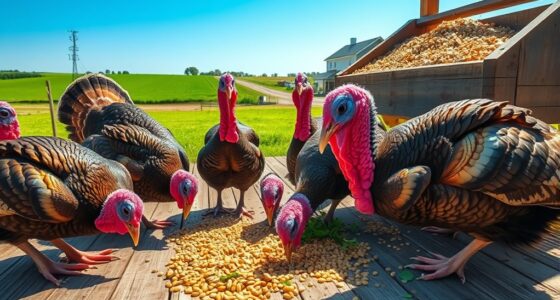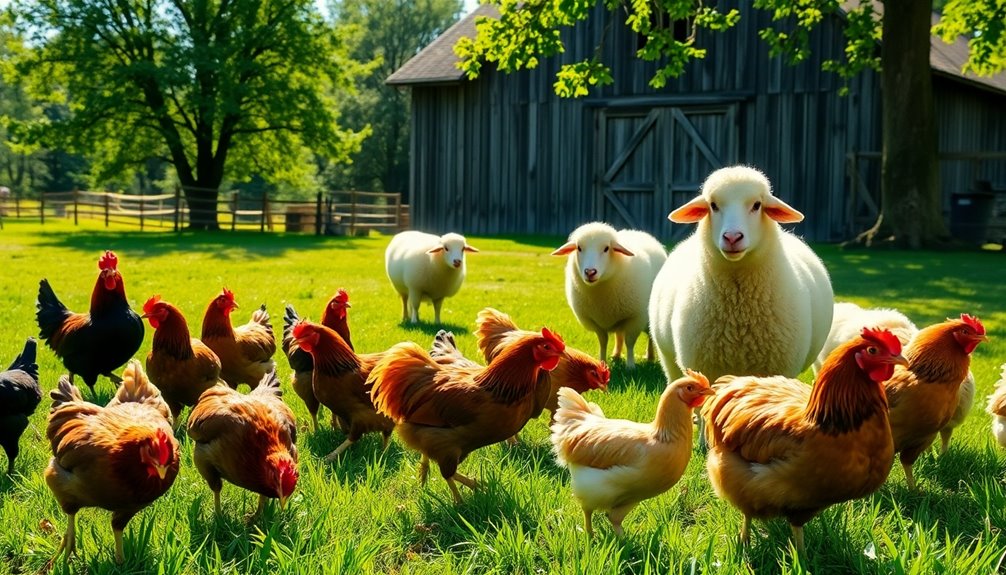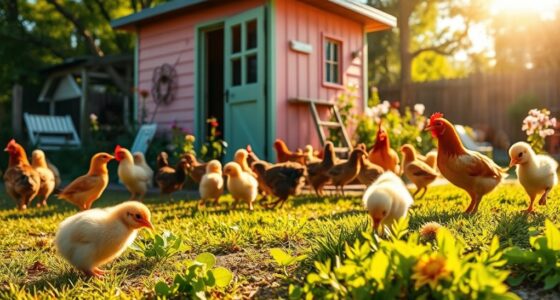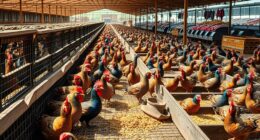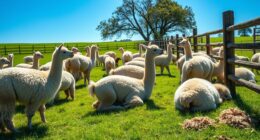To shift your dairy herd from summer pasture to fall hay, start by gradually reducing pasture grazing while slowly increasing hay intake over 7-10 days. Monitor forage quality through testing and adjust energy and protein levels accordingly. Incorporate mineral and vitamin supplements as needed, and watch for changes in cow behavior or manure that may signal issues. For more detailed steps, you’ll find helpful tips to keep your herd healthy and productive during the switch.
Key Takeaways
- Gradually reduce pasture grazing while increasing hay intake over 7-10 days to prevent digestive upset.
- Test fall hay for nutrient content and adjust rations to meet energy and protein requirements accordingly.
- Incorporate incremental feed changes, monitoring animal behavior and manure consistency for early signs of discomfort.
- Supplement with concentrates or nutritional additives if forage quality declines or energy needs are unmet.
- Maintain consistent monitoring of herd health, forage intake, and manure to ensure a smooth transition.
Assessing the Nutritional Needs During Seasonal Transition
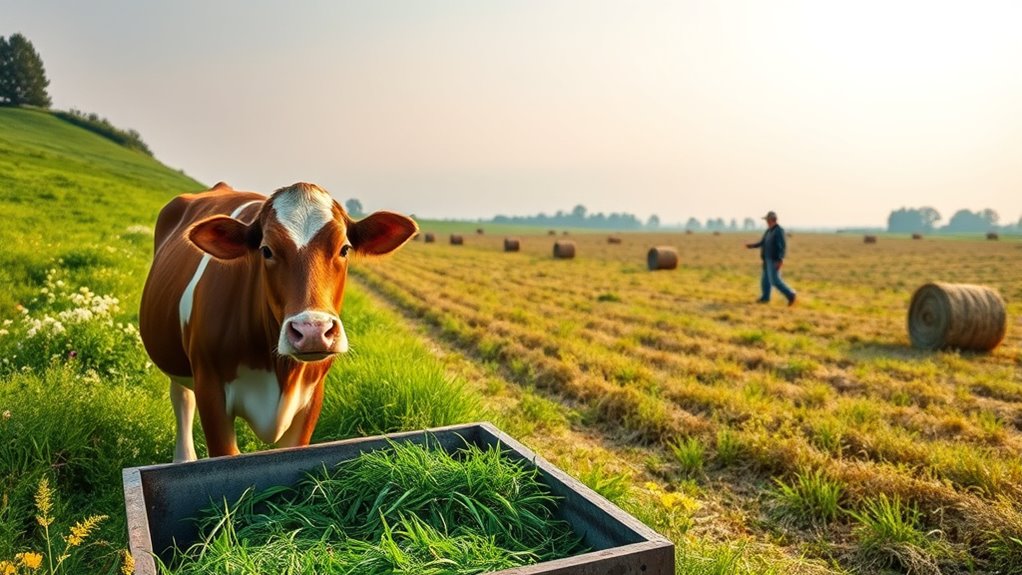
As seasons change, dairy cattle’s nutritional needs shift to accommodate altered environmental conditions and production demands. To meet these changing needs, you should evaluate your forage base, focusing on crop rotation and pasture restoration. Crop rotation helps maintain soil fertility and reduces weed pressure, ensuring high-quality forage availability. Restoring pastures after summer grazing is essential to rebuild plant vigor and improve nutrient content, which directly impacts your cattle’s diet. As pasture quality declines with the season, adjust your feed plan accordingly, supplementing with hay or concentrates if necessary. Monitoring forage growth and health allows you to identify nutrient gaps early, ensuring your dairy cattle receive balanced nutrition during this changeover period. Proper assessment helps maintain production levels and animal health as environmental conditions shift. Incorporating soil health management practices can further enhance forage quality and sustainability throughout the seasonal transition. Additionally, understanding nutritional requirements for different stages of lactation ensures your herd remains productive and healthy during this period. Regular forage testing can help you fine-tune your supplementation strategy and prevent deficiencies, and staying informed about regulatory standards ensures compliance with feed quality regulations.
Monitoring Forage Quality and Quantity
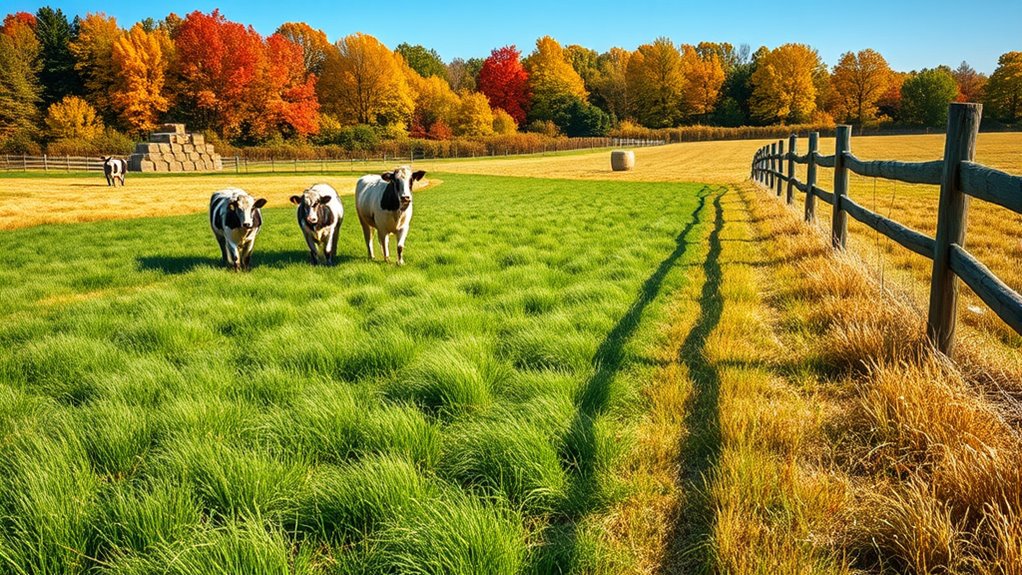
Monitoring forage quality and quantity is essential to guarantee your dairy cattle receive a balanced diet as seasonal conditions change. Regularly assess your pasture rotation to prevent overgrazing and ensure forage availability. Conduct forage testing to measure nutrient levels like crude protein, fiber, and energy, helping you adjust rations accurately. Keep track of forage biomass to determine how much feed is available and when to supplement or switch to harvested hay. Use the table below to understand key factors influencing forage quality:
| Forage Aspect | Impact on Dairy Rations |
|---|---|
| Pasture rotation | Maintains fresh, nutritious grazing |
| Forage testing | Guides precise diet adjustments |
| Quantity | Ensures sufficient feed supply |
Consistent monitoring keeps your herd healthy during seasonal shifts.
Gradually Adjusting Rations to Prevent Digestive Distress
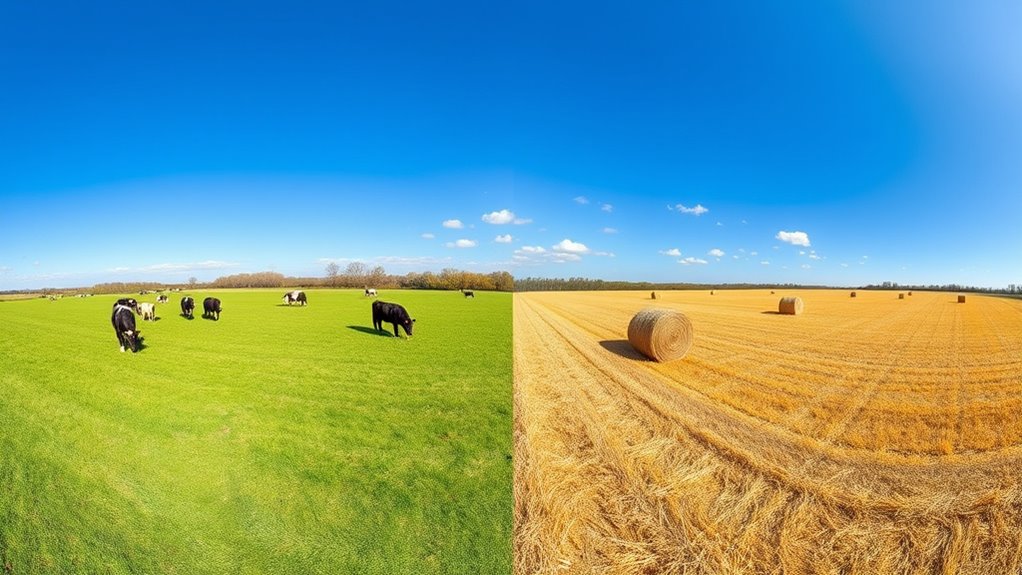
To prevent digestive upset, you should make dietary changes gradually, increasing new feed over several days. Keep a close eye on your animals’ responses, watching for signs of discomfort or reduced intake. By maintaining a balanced diet throughout the changeover, you help guarantee their health and productivity stay on track.
Incremental Dietary Changes
Gradually adjusting dairy rations helps prevent digestive upset and guarantees a smoother transition for your herd. Start by slowly introducing fall hay while reducing pasture grazing over 7-10 days. Incorporate nutritional supplements as needed to support digestion and maintain nutrient intake. During pasture rotation, monitor how cows adapt to new forage types, adjusting the ration accordingly. Use the table below to understand the importance of incremental changes:
| Key Point | Benefit |
|---|---|
| Slow diet changes | Prevents digestive disturbances |
| Nutritional supplements | Supports herd health during transition |
| Pasture rotation adjustments | Ensures consistent nutrient intake |
| Gradual reduction of pasture | Minimizes stress and digestive upset |
Stick to small, steady shifts to keep digestion smooth and herd comfort high. Implementing gradual dietary changes is essential for maintaining herd health during seasonal transitions. Additionally, understanding proper fermentation processes can help prevent issues that might interfere with farm operations during this period. Being aware of emergency preparedness essentials can also help mitigate unforeseen disruptions during seasonal changes, ensuring herd safety and farm continuity.
Monitor Animal Response
Keeping a close eye on how your herd responds during dietary adjustments guarantees they stay healthy and comfortable. Watch for changes in animal behavior, such as decreased appetite, restlessness, or signs of discomfort, which may indicate digestive issues. Pay attention to herd dynamics—if some cows become more dominant or exhibit stress, it could affect their intake and digestion. Observe manure consistency; loose or overly firm stool signals the need to slow or modify the progression. Regularly monitor each animal’s condition and behavior, and be ready to make quick adjustments if you notice signs of distress. Staying attentive ensures you can catch potential problems early, reducing the risk of digestive upset and maintaining overall herd health during the ration transition. Additionally, understanding precious metals market trends can help you make informed decisions if you consider diversifying your investment portfolio during times of change. Recognizing the importance of emotional alignment can also help foster a calm herd environment, as stress can impact digestion and overall health. Being mindful of animal behavior cues enables prompt intervention, further safeguarding herd well-being. Incorporating behavioral observations into your routine allows for more precise management of dietary shifts, minimizing stress responses. For example, monitoring feed intake patterns can provide early warnings of potential issues before they escalate.
Maintain Nutritional Balance
Adjusting dairy rations carefully is essential to prevent digestive upset and maintain herd health. To facilitate a smooth transition from pasture to hay, focus on maintaining nutritional balance by gradually adjusting feed quantities. Keep in mind that dairy cow genetics influence how quickly your herd adapts, so tailor changes accordingly. As pasture recovers, monitor forage quality and adjust rations to match energy and fiber needs. You should also observe behavioral changes to identify early signs of dietary imbalance and intervene promptly. Introducing new feeds slowly can help prevent fermentation shifts that may cause digestive issues. Monitor manure consistency for signs of imbalance. Keep an eye on milk production and cow behavior. Adjust mineral and vitamin levels as needed. Ensure enough fiber to support pasture recovery and digestion. Understanding cow nutrition is key to a successful transition, helping your herd adapt without stress, promoting health and productivity. Additionally, staying informed about automation in business can lead to more efficient management practices during such seasonal changes. Incorporating regular health assessments can further enhance your ability to detect and address potential issues early.
Balancing Energy and Protein Levels in Fall Diets
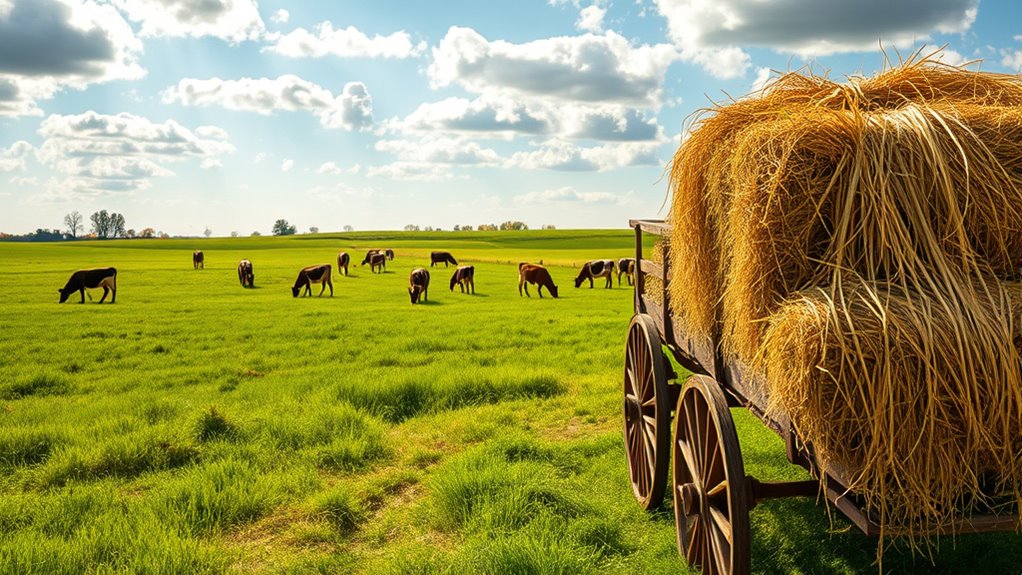
To guarantee your cows stay healthy and productive this fall, you need to balance energy and protein levels carefully. Adjust your energy sources to meet changing needs, and manage protein intake to avoid excess or deficiency. Keep a close eye on the overall nutritional balance to support ideal performance and health. Incorporating appropriate nutrition management strategies can further optimize your herd’s well-being during this transition. Regular monitoring and adjustments help maintain optimal homeostasis, ensuring your cattle adapt well to seasonal changes. Additionally, considering home heating solutions like heat pumps can improve the comfort and health of your barn environments during colder months. Proper feeding practices during this period are essential to prevent metabolic disorders and ensure sustained productivity. Paying attention to the characteristics of a healthy diet can guide you in providing balanced rations.
Adjusting Energy Sources
As fall approaches, it becomes essential to carefully balance energy and protein levels in dairy rations to support milk production and herd health. Adjusting energy sources involves optimizing grain supplementation to meet increased energy demands. You should also monitor fiber intake, ensuring it’s sufficient for rumen health without compromising energy density. Consider these tips:
- Increase grain supplementation gradually to prevent digestive upset
- Balance energy-dense feeds with adequate fiber for proper digestion
- Use high-quality forage to boost energy levels naturally
- Avoid excessive grain to prevent acidosis
- Keep an eye on feed intake to adjust energy sources accordingly
Managing Protein Levels
Balancing protein levels alongside energy sources helps guarantee peak milk production and herd health during fall. Proper protein supplementation ensures your cows meet their nutritional needs without excess, which can cause inefficiencies. Monitor forage protein levels closely, as high forage protein may reduce the need for additional supplementation, while low forage protein requires strategic adjustments. To optimize your diet, consider this table:
| Forage Protein Level | Recommended Action | Notes |
|---|---|---|
| High | Reduce protein supplementation | Avoid overfeeding and waste |
| Moderate | Maintain current supplementation | Balanced for energy and protein |
| Low | Increase protein supplementation | Use supplemental feeds wisely |
| Very low | Supplement with high-protein feeds | Prevent production drops |
Maintaining the right balance helps your herd produce efficiently and stay healthy.
Monitoring Nutritional Balance
Monitoring nutritional balance is essential during fall to guarantee your herd receives the right combination of energy and protein for ideal production and health. As you shift from summer pasture to fall hay, keep a close eye on how well your diet meets their needs. Proper silage preservation ensures nutrients stay intact, preventing imbalances. Regularly assess forage quality, adjusting rations as needed. Incorporate effective pasture rotation to maintain consistent forage availability and nutrient levels. Use feed analysis results to fine-tune energy and protein levels, avoiding excess or deficiencies. Watch for signs of metabolic issues or decreased productivity, which indicate your herd’s nutritional needs might be off. Staying vigilant helps you optimize production and herd health through a balanced fall diet.
Managing Mineral and Vitamin Supplementation

Effective management of mineral and vitamin supplementation is essential to guarantee your dairy cows stay healthy and produce efficiently. During this changeover, prioritize mineral supplementation tailored to seasonal changes, ensuring your cows receive the necessary trace minerals and macrominerals. Proper vitamin balancing supports immune function, reproductive health, and milk production. Regularly analyze your feed and forage to identify deficiencies, then adjust supplements accordingly. Avoid over-supplementation, which can lead to toxicity or waste. Use a balanced mineral mix that complements your pasture and hay quality, and consider incorporating specific vitamins like A, D, and E if levels are low. Consistent monitoring and fine-tuning of your supplementation program help optimize health and productivity while minimizing costs.
Implementing Feeding Strategies to Maintain Milk Production
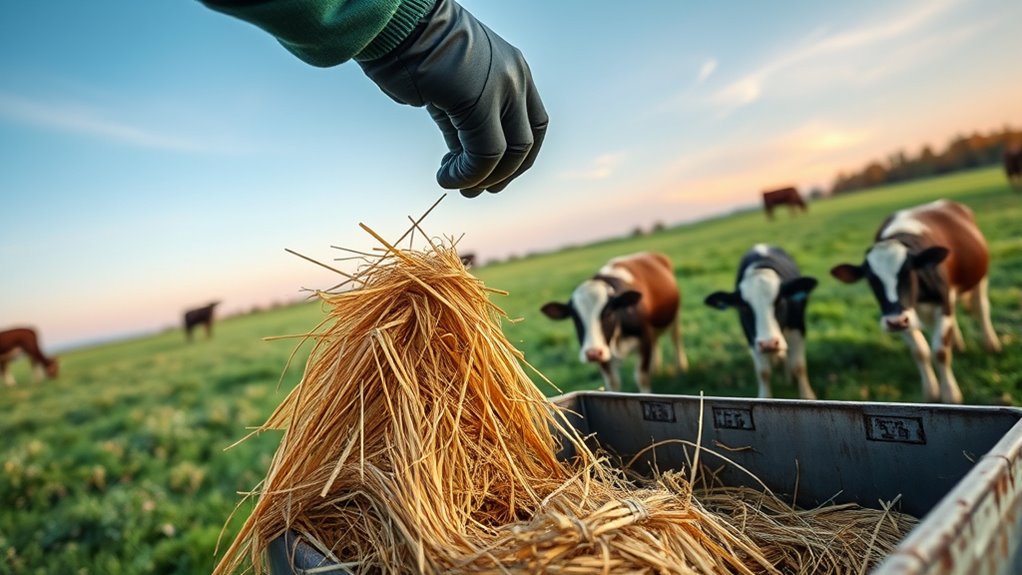
As you shift your dairy cows to new feed regimens, implementing strategic feeding practices is essential to maintaining consistent milk production. Proper feed storage guarantees quality and minimizes waste, so keep hay and supplements in dry, ventilated areas. Adjust pasture rotation to prevent overgrazing and maintain nutritional value, gradually introducing fall hay to avoid digestion issues. Consider mixing feeds to balance energy and protein levels, supporting milk yield. Monitor feed intake closely, offering consistent amounts to prevent fluctuations. Keep water available at all times, especially during transitions. Regularly evaluate feed quality, and make adjustments as needed to meet your cows’ nutritional needs while preserving milk production levels. These strategies help your herd adapt smoothly and sustain productivity through seasonal changes.
Observing Cow Behavior and Health Indicators
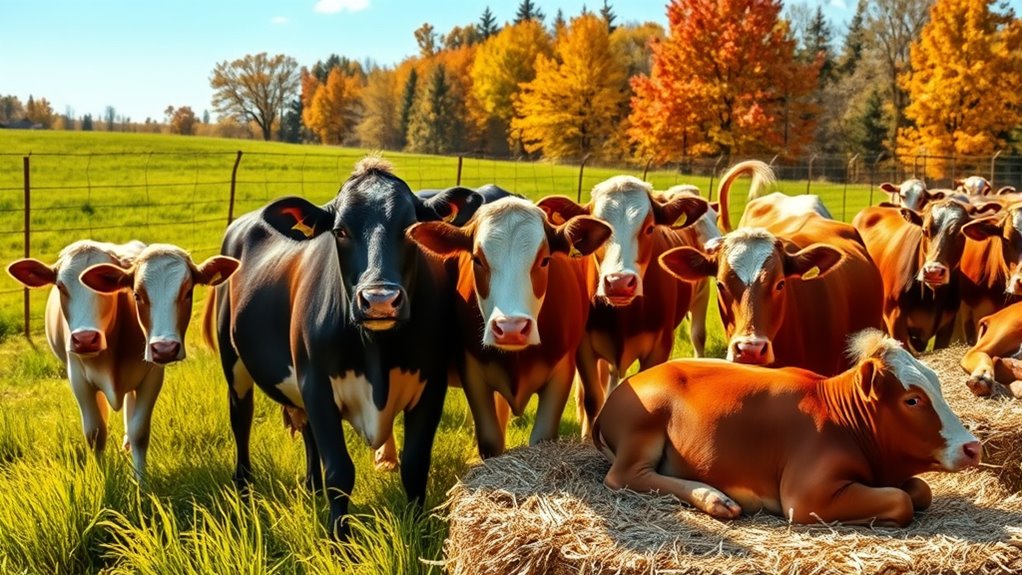
Keeping a close eye on your cows’ behavior and health indicators helps guarantee their well-being and sustained productivity during feed adjustments. Watch for signs of cow comfort, such as lying time, eating rate, and social interactions, to ensure they’re adapting well. Pay attention to stress indicators like restlessness, vocalizations, or decreased feed intake, which can signal discomfort or health issues. Sudden changes in behavior may indicate problems like pain, illness, or environmental stress, requiring prompt action. Regularly observe their posture, movement, and manure consistency to catch early health concerns. Maintaining cow comfort is key; comfortable cows are more likely to adjust smoothly to the new ration, minimizing stress and supporting overall health and milk production.
Planning for Long-Term Feed Storage and Management
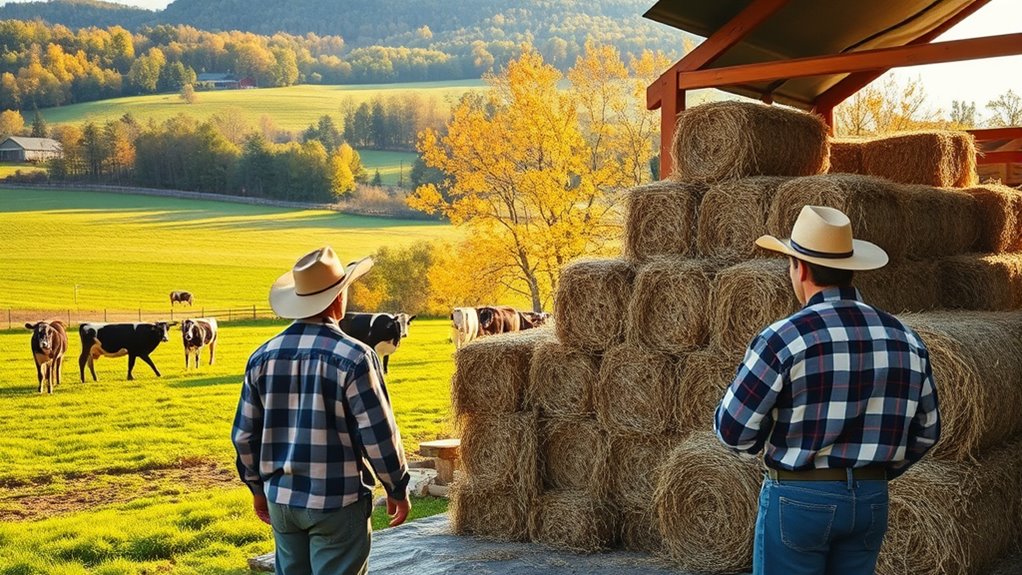
Planning for long-term feed storage and management is vital to guarantee a consistent and high-quality supply of feed for your herd. Proper grain management helps prevent spoilage and pest issues, while effective pasture rotation preserves pasture health and reduces overgrazing. To stay organized, consider these strategies:
- Store grains in cool, dry, airtight containers
- Regularly monitor feed quality and moisture levels
- Implement a pasture rotation schedule to optimize grazing
- Use silos or covered storage for hay and silage
- Keep detailed records of feed inventories and rotations
Frequently Asked Questions
How Do Weather Changes Affect Forage Availability During Fall Transition?
Weather changes notably impact forage availability during fall transition. Climate variability can lead to unpredictable temperatures and rainfall, which directly affect forage growth patterns. Warm, wet conditions promote lush growth, while early frosts or droughts can reduce forage quality and quantity. As a result, you might need to adjust your feeding plan to guarantee your dairy herd continues to receive adequate nutrition despite these weather-driven fluctuations in forage supply.
What Are Common Signs of Nutritional Deficiencies in Dairy Cows?
You might think your cows are thriving, but signs of deficiencies often whisper otherwise. Watch for mineral imbalances, like weak hooves or poor growth, and digestive issues such as diarrhea or bloating. These clues reveal nutritional gaps that can sneak in unnoticed, especially during seasonal changes. Stay vigilant; even healthy-looking cows can hide subtle signs of underlying problems, reminding you that sometimes appearance can be deceiving.
How Can I Reduce Feed Costs During Seasonal Shifts?
To reduce feed costs during seasonal shifts, you should focus on implementing cost-effective supplements and optimizing grazing management. You can extend pasture grazing by rotating cattle strategically, which minimizes hay and concentrate use. Incorporate affordable supplements that meet nutritional needs without overspending. Monitoring pasture growth and adjusting intake accordingly helps you balance costs and maintain cow health, ensuring a smooth progression and efficient feed management during seasonal changes.
What Are Best Practices for Handling Moldy or Spoiled Hay?
Did you know that up to 20% of stored hay can be moldy if not properly handled? When dealing with moldy or spoiled hay, you should prioritize mold prevention by inspecting and testing the hay before use. If mold is detected, discard heavily affected bales, as feeding moldy hay can harm your cows’ health. Proper hay testing helps identify contamination early, ensuring you maintain safe, nutritious feed for your herd.
How Do I Manage Pests That Affect Stored Forage Quality?
To manage pests affecting stored forage quality, start with pest identification to determine the specific pests, like beetles or rodents. Then, implement pest control strategies such as proper sanitation, regular inspections, and using airtight storage containers. Keep storage areas dry and clean, remove infested hay promptly, and consider natural or chemical deterrents if needed. Consistent monitoring helps prevent pest damage and maintains forage quality effectively.
Conclusion
As you shift your dairy cows from summer pasture to fall hay, think of it as guiding them across a changing landscape. By carefully monitoring their needs and adjusting rations gradually, you’ll help them adapt smoothly—like easing into a gentle stream. Keep a close eye on their health and behavior, and stay proactive with supplementation. With attentive management, you’ll ensure your herd remains healthy and productive, weathering the seasonal shift as naturally as the leaves turn.




